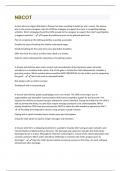Exam (elaborations)
NBCOT 2024 QUESTIONS WITH ALL CORRECT ANSWERS, GRADED A+
- Course
- Institution
A client who has stage 6 Alzheimer's disease has been unwilling to bathe for over a week. The spouse, who is the primary caregiver, asks the COTA for strategies to support the client in completing bathing activities. Which strategies should the COTA provide to the caregiver to support the client'...
[Show more]



